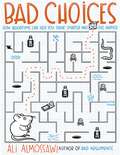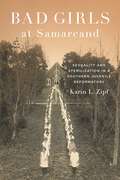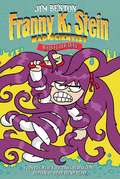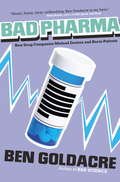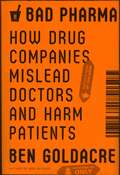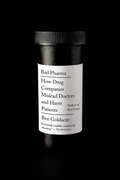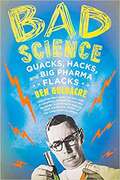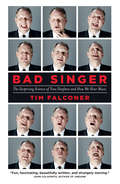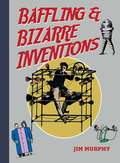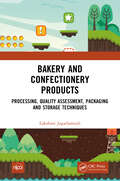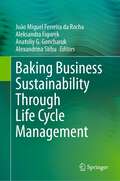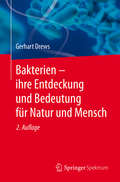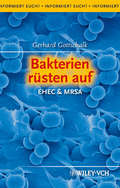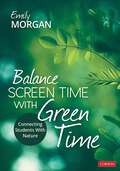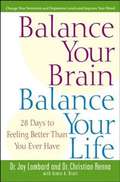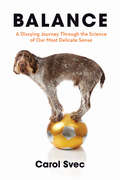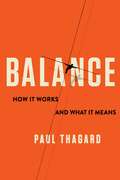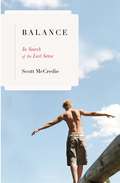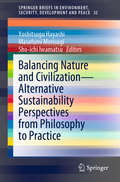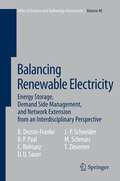- Table View
- List View
Bad Choices: How Algorithms Can Help You Think Smarter and Live Happier
by Ali AlmossawiA relatable, interactive, and funny exploration of algorithms, those essential building blocks of computer science - and of everyday life - from the author of the wildly popular Bad Arguments.Algorithms -- processes that are made up of unambiguous steps and do something useful -- make up the very foundations of computer science. Yet, they also inform our choices in approaching everyday tasks, from managing a pile of clothes fresh out of the dryer to deciding what music to listen to.With Bad Choices, Ali Almossawi, presents twelve scenes from everyday life that help demonstrate and demystify the fundamental algorithms that drive computer science, bringing these seemingly elusive concepts into the understandable realms of the everyday.Readers will discover how:· Matching socks can teach you about search and hash tables· Planning trips to the store can demonstrate the value of stacks· Deciding what music to listen to shows why link analysis is all-important· Crafting a succinct Tweet draws on ideas from compression· Making your way through a grocery list helps explain priority queues and traversing graphs · And moreAs you better understand algorithms, you'll also discover what makes a method faster and more efficient, helping you become a more nimble, creative problem-solver, ready to face new challenges. Bad Choices will open the world of algorithms to all readers making this a perennial go-to for fans of quirky, accessible science books.
Bad Girls at Samarcand: Sexuality and Sterilization in a Southern Juvenile Reformatory
by Karin L. ZipfOf the many consequences advanced by the rise of the eugenics movement in the early twentieth century, North Carolina forcibly sterilized more than 2,000 women and girls in between 1929 and 1950. This extreme measure reflects how pseudoscience justified widespread gender, race, and class discrimination in the Jim Crow South. In Bad Girls at Samarcand Karin L. Zipf dissects a dark episode in North Carolina's eugenics campaign through a detailed study of the State Home and Industrial School in Eagle Springs, referred to as Samarcand Manor, and the school's infamous 1931 arson case. The people and events surrounding both the institution and the court case sparked a public debate about the expectations of white womanhood, the nature of contemporary science and medicine, and the role of the juvenile justice system that resonated throughout the succeeding decades. Designed to reform and educate unwed poor white girls who were suspected of deviant behavior or victims of sexual abuse, Samarcand Manor allowed for strict disciplinary measures -- including corporal punishment -- in an attempt to instill Victorian ideals of female purity. The harsh treatment fostered a hostile environment and tensions boiled over when several girls set Samarcand on fire, destroying two residence halls. Zipf argues that the subsequent arson trial, which carried the possibility of the death penalty, represented an important turning point in the public characterizations of poor white women; aided by the lobbying efforts of eugenics advocates, the trial helped usher in dramatic policy changes, including the forced sterilization of female juvenile delinquents. In addition to the interplay between gender ideals and the eugenics movement, Zipf also investigates the girls who were housed at Samarcand and those specifically charged in the 1931 trial. She explores their negotiation of Jazz Age stereotypes, their strategies of resistance, and their relationship with defense attorney Nell Battle Lewis during the trial. The resultant policy changes -- intelligence testing, sterilization, and parole -- are also explored, providing further insight into why these young women preferred prison to reformatories.
Bad Hair Day (Franny K. Stein, Mad Scientist #8)
by Jim BentonFranny K. Stein is back with another laugh-out-loud experimental adventure in the eighth book in the Mad Scientist series from Jim Benton, the New York Times bestselling author-illustrator of Dear Dumb Diary and Happy Bunny.Franny K. Stein isn’t a fan of glamour. She doesn’t style her hair, the thought of wearing makeup makes her want to gag, and she couldn’t care less about wearing dressy dresses when she’d much prefer her lab coat. But sometimes Franny wonders if her mom wishes she were different. Which gives Franny an idea…for an experiment! What if she can turn the beauty products her mom loves into something more exciting? Every experiment has its experimental error, and when Franny’s hair takes on a life of its own, Franny must save the day (and her hair) to finally realize her mom loves her just the way she is.
Bad Pharma
by Ben GoldacreWe all feel uncomfortable about the role of profit in healthcare, we all have a vague notion that the global $600bn pharmaceutical industry is somehow evil and untrustworthy, but that sense rarely goes beyond a flaky, undifferentiated new age worldview. Bad Pharma puts real flesh on those bones, revealing the rigged evidence used by drug companies. Bad information means bad treatment decisions, which means patients suffer and die: there is no climactic moment of villainy, but drugs are used which are overpriced, less effective, and have more side effects. There are five cheap, easy things we can do to fix the problem. Bad Pharma takes a big dirty secret out into the open, and will provide a single focus for concerns people have both inside and outside medicine.
Bad Pharma: How Drug Companies Mislead Doctors And Harm Patients
by Ben GoldacreWe like to imagine that medicine is based on evidence and the results of fair testing and clinical trials. In reality, those tests and trials are often profoundly flawed. We like to imagine that doctors who write prescriptions for everything from antidepressants to cancer drugs to heart medication are familiar with the research literature about a drug, when in reality much of the research is hidden from them by drug companies. We like to imagine that doctors are impartially educated, when in reality much of their education is funded by the pharmaceutical industry. We like to imagine that regulators have some code of ethics and let only effective drugs onto the market, when in reality they approve useless drugs, with data on side effects casually withheld from doctors and patients. All these problems have been shielded from public scrutiny because theyre too complex to capture in a sound bite. But Ben Goldacre shows that the true scale of this murderous disaster fully reveals itself only when the details are untangled. He believes we should all be able to understand precisely how data manipulation works and how research misconduct in the medical industry affects us on a global scale. With Goldacres characteristic flair and a forensic attention to detail, "Bad Pharma "reveals a shockingly broken system and calls for regulation. This is the pharmaceutical industry as it has never been seen before.
Bad Pharma: How Drug Companies Mislead Doctors and Harm Patients
by Ben GoldacreWe like to imagine that medicine is based on evidence and the results of fair testing and clinical trials. In reality, those tests and trials are often profoundly flawed. We like to imagine that doctors who write prescriptions for everything from antidepressants to cancer drugs to heart medication are familiar with the research literature about a drug, when in reality much of the research is hidden from them by drug companies. We like to imagine that doctors are impartially educated, when in reality much of their education is funded by the pharmaceutical industry. We like to imagine that regulators have some code of ethics and let only effective drugs onto the market, when in reality they approve useless drugs, with data on side effects casually withheld from doctors and patients. All these problems have been shielded from public scrutiny because they're too complex to capture in a sound bite. But Ben Goldacre shows that the true scale of this murderous disaster fully reveals itself only when the details are untangled. He believes we should all be able to understand precisely how data manipulation works and how research misconduct in the medical industry affects us on a global scale. With Goldacre's characteristic flair and a forensic attention to detail, Bad Pharma reveals a shockingly broken system and calls for regulation. This is the pharmaceutical industry as it has never been seen before.
Bad Science: Quacks, Hacks, And Big Pharma Flacks
by Ben GoldacreHave you ever wondered how one day the media can assert that alcohol is bad for us and the next unashamedly run a story touting the benefits of daily alcohol consumption? Or how a drug that is pulled off the market for causing heart attacks ever got approved in the first place? How can average readers, who aren't medical doctors or Ph.D.s in biochemistry, tell what they should be paying attention to and what's, well, just more bullshit? Ben Goldacre has made a point of exposing quack doctors and nutritionists, bogus credentialing programs, and biased scientific studies. He has also taken the media to task for its willingness to throw facts and proof out the window. But he's not here just to tell you what's wrong. Goldacre is here to teach you how to evaluate placebo effects, double-blind studies, and sample sizes, so that you can recognize bad science when you see it. You're about to feel a whole lot better.
Bad Singer: The Surprising Science of Tone Deafness and How We Hear Music
by Tim FalconerIn the tradition of Daniel Levitin’s This Is Your Brain on Music and Oliver Sacks’ Musicophilia, Bad Singer follows the delightful journey of Tim Falconer as he tries to overcome tone deafness — and along the way discovers what we’re really hearing when we listen to music.Tim Falconer, a self-confessed “bad singer,” always wanted to make music, but soon after he starts singing lessons, he discovers that he’s part of only 2.5 percent of the population afflicted with amusia — in other words, he is scientifically tone-deaf. Bad Singer chronicles his quest to understand human evolution and music, the brain science behind tone-deafness, his search for ways to retrain the adult brain, and his investigation into what we really hear when we listen to music. In an effort to learn more about his brain disorder, he goes to a series of labs where the scientists who test him are as fascinated with him as he is with them. He also sets out to understand why we love music and deconstructs what we really hear when we listen to it. And he unlocks the secret that helps explain why music has such emotional power over us.
Badass Bricks: Thirty-Five Weapons of Mass Construction
by Jake MackayLEGO is fun. So are toy weapons. The only thing more fun is LEGO toy weapons! A compilation of badass brick weapons--some that actually even work--this book is designed for the adult brick enthusiast. Each project is original (i.e., not from a LEGO kit) and is accompanied by how-to schematics and full-color original photographs of the finished object. Dangerous and exciting projects include:TomahawkBroadswordClaymore (two-handed sword)Ninja throwing starM1911 pistolSiege towerGatling gunMK2 grenadeScythed chariotParis gunFlamethrowerAnd many more!Hobbyists love to make weapons, and this book goes far beyond the kits that are available to showcase forty projects for amazing weapons. The projects range from medieval to modern, from small hand grenades to an actual working guillotine to an assault amphibious vehicle. Badass Bricks will keep adults occupied for hours and is the perfect book for the adult brick enthusiast, weapons hobbyist, or all-around badass!
Baffling & Bizarre Inventions
by Jim MurphyA talking watch. An overcoat for two. A pair of pants for poodles. In his companion to Weird & Wacky Inventions, Jim Murphy shows kids some additional baffling and utterly silly inventions in the form of a guessing game that is both challenging and fun. What is a finger-supporting device used for? Can you really buy that talking watch? What on earth is a beard grinder? Whether it's a device for shaping the upper lip or a life preserver for horses, this parade of unusual inventions is a real treat for trivia lovers and any curious kid with an interest in science and inventions. Ages: 9-12.
Bakery and Confectionery Products: Processing, Quality Assessment, Packaging and Storage Techniques
by Lakshmi JagarlamudiThis book is a comprehensive and practical day-to-day reference for undergraduate and postgraduate students in the discipline of Food Science and Technology. Different topics are discussed to provide a comprehensive knowledge of the theoretical as well as the applied aspects involved in processing of bakery and confectionery products to gain confidence in any dedicated reader to go for a startup in the field. It also covers information on ingredients to bakery and confectionery products, formulae and processes for bakers, equipment for bakers and confectionery units along with quality assessment and standards. It will also help those connected with industries – who supply ingredients, equipment and packaging materials for bakery and confectionery units. The book is also useful for students appearing in any competitive examination in the disciplines of Food Science, Food Science, Nutrition, and Food Technology. This title is co-published with NIPA. Taylor and Francis does not sell or distribute its print and electronic editions in India, Pakistan, Nepal, Bhutan, Bangladesh and Sri Lanka.
Baking Business Sustainability Through Life Cycle Management
by João Miguel Ferreira da Rocha Aleksandra Figurek Anatoliy G. Goncharuk Alexandrina SirbuThis timely and comprehensive text focuses on important recent advances in applied sustainability in the baking industry, connecting all of the current methods and strategies into a single book. Those involved in bread production will find the latest developments at the theoretical and practical levels, including information and communication requirements, reporting and regulatory aspects, economic and environmentally sustainable business models, supply chain management, life cycle assessment, product and organizational environmental footprints and more. For small bakery business owners to industry leaders and policymakers, governmental authorities, regulatory authorities and standardization bodies, this book offers a compilation of technical information about sustainability in the market for the bakery sector. Life Cycle Thinking In Managing Baking Business Sustainability begins by presenting basic information on the life cycle assessment and product environmental footprint of the bread industry, proposing an analysis of sustainability assessment using environmental and social footprints and providing recommendations for integral optimization of economic and environmental performance. A second section focuses on sustainability in the baking industry, providing a regional focus from Europe to The Americas to Africa and beyond. The third section takes a deep look at economic feasibility and efficiency in the bread industry, including an important chapter on the market risk and external shock effects from COVID-19, the economic viability of different scenarios for bread-based value chains, and forming efficient business models for bakeries. A final section zeroes in on the most up-to-date innovations in the current bakery industry, including the impact of bakery innovation on business resilience growth, commercial systems, and new business models in regional food systems for farmers and companies, based on multi-actor approach. Innovations within the bakery industry are at an all-time high, with new sustainability and economic models being introduced, along with associated market risks. This timely and ambitious text aims to cover all of the most recent advances and methods for successful incorporation into bakery businesses.
Bakterien - ihre Entdeckung und Bedeutung für Natur und Mensch
by Gerhart DrewsVon den Anfängen naturwissenschaftlichen Denkens in der Antike über das Mikroskop bis zur synthetischen Biologie. Mikroorganismen leisten einen wesentlichen Beitrag zum Kreislauf der Stoffe in der Natur. Sie haben die Voraussetzung für das Leben der höheren Organismen geschaffen und synthetisieren wichtige Wirkstoffe wie Vitamine und Antibiotika. Gerhart Drews schildert die Ideengeschichte der Mikrobiologie. Er bringt dem Leser die Welt einiger Denker, Forscher und auch wissbegieriger Laien aus vergangenen Jahrhunderten näher. Er beschreibt die wesentlichen Entdeckungen, die zur Erkennung der Mikroorganismen, ihrer Rolle in der Natur und bei der Entstehung von Krankheiten geführt haben. In der modernen Zeit schildert er die Entwicklung exemplarisch anhand einzelner Organismen oder Themenfelder unter Einbeziehung der wesentlichen Entdeckungen in Molekularbiologie und Genetik. In der 2. , überarb. und aktual. Auflage sind einige Kapitel erweitert.
Bakterien rüsten auf: EHEC & MRSA
by Gerhard GottschalkEin bemerkenswertes Büchlein; flott zu lesen, hochaktuell und trotzdem unterhaltsam. Gerhard Gottschalk, einer der prominentesten zeitgenössischen Mikrobiologen erklärt hier die Hintergründe der EHEC und MRSA Epidemien. Trotz des ernsten Themas liest sich das Buch leicht und man spürt keinen erhobenen Zeigefinger. Dafür lernt man erstaunliches, z.B. dass das EHEC zu Grunde liegende -harmlose- Darmbakterium Escherichia Coli schon sehr lange auf der Erde existiert und ein vielfaches länger in den Gedärmen von Dinosauriern als denen von Menschen hauste. Auch über MRSA, ein Bakterium mit dem mittlerweile eine erschreckend hohe Anzahl von Patienten in Kliniken konfrontiert wird, erfährt der Leser einiges, vor allem wie sich dieser ursprünglich ebenfalls relativ harmlose Keim zu so einem gefährlichen Dauerbewohner in vielen Krankenhäusern entwickeln konnte, und warum wir solche Schwierigkeiten haben, das Problem in den Griff zu bekommen. Last but not least ist dieses Buch ein schönes Beispiel dafür, dass Evolution kein abstrakter Vorgang in ferner Vergangenheit ist, sondern 'live` unser alltägliches Leben tiefgreifender beeinflussen kann als uns das zuweilen lieb ist.
Balance Screen Time With Green Time: Connecting Students With Nature
by Emily MorganHarness the power of nature to nurture minds and hearts Youth spend anywhere between four and nine hours on screens every single day. Meanwhile, a growing body of research shows how detrimental excessive screen time is on physical and mental health. The antidote? Green time. Written by bestselling author and science educator Emily Morgan, Balance Screen Time With Green Time gives teachers and school leaders practical, evidence-based strategies that seamlessly incorporate the restorative power of nature into the school day. Transform learning experiences and improve student and educator well-being with: Research-based strategies that improve attention, engagement, pro-environmental behaviors, and mental and physical health while reducing stress Dozens of easy-to-implement "green breaks"—short, invigorating experiences with nature—that help students and teachers renew and refocus throughout the school day Stories of innovative educators who connect students with nature and offer meaningful ways to integrate green time while enhancing learning A curated collection of resources to support educators of all grade levels, content areas, and school environments—urban, suburban, and rural With green time, we have an opportunity to create a generation of students who are not only more connected to the natural world, but are also the environmental stewards our future so desperately needs. Balancing screen time with green time is an investment in student well-being, our collective future, and a healthier planet.
Balance Screen Time With Green Time: Connecting Students With Nature
by Emily MorganHarness the power of nature to nurture minds and hearts Youth spend anywhere between four and nine hours on screens every single day. Meanwhile, a growing body of research shows how detrimental excessive screen time is on physical and mental health. The antidote? Green time. Written by bestselling author and science educator Emily Morgan, Balance Screen Time With Green Time gives teachers and school leaders practical, evidence-based strategies that seamlessly incorporate the restorative power of nature into the school day. Transform learning experiences and improve student and educator well-being with: Research-based strategies that improve attention, engagement, pro-environmental behaviors, and mental and physical health while reducing stress Dozens of easy-to-implement "green breaks"—short, invigorating experiences with nature—that help students and teachers renew and refocus throughout the school day Stories of innovative educators who connect students with nature and offer meaningful ways to integrate green time while enhancing learning A curated collection of resources to support educators of all grade levels, content areas, and school environments—urban, suburban, and rural With green time, we have an opportunity to create a generation of students who are not only more connected to the natural world, but are also the environmental stewards our future so desperately needs. Balancing screen time with green time is an investment in student well-being, our collective future, and a healthier planet.
Balance Your Brain, Balance Your Life: 28 Days to Feeling Better Than You Ever Have
by Armin A. Brott Jay Lombard Christian RennaExplaining why an imbalance in our brain chemistry is behind a range of health problems, this book tells us what we can do to restore balance and achieve unprecedented levels of physical, mental, and emotional well being. It also explains how to treat serious imbalances, in consultation with a physician, using hormones, antidepressants, and more.
Balance: A Dizzying Journey Through the Science of Our Most Delicate Sense
by Carol SvecSome low-frequency sounds—such as noise from storms or truck engines—can make you feel dizzy and nauseated. An index finger's light touch can stop people from losing balance. You are more prone to trip when you think someone is watching you. A breakthrough in improving balance as we age might just come through the study of the Achilles tendon. A person gets "falling down drunk" due to a tiny structure in the inner ear that floats when it becomes soaked in alcohol. These and other surprising and useful nuggets of information can be found in this lively, 360-degree exploration of our body's most intricate, overlooked sense—balance. Readers follow award-winning science and health writer Carol Svec through various facilities as she talks with leading scientists doing state-of-the-art balance research. Svec translates their most fascinating findings for the layperson in a way that is highly entertaining and broadly accessible. She showcases the coolest gadgets used by researchers as she grills an egg in a virtual kitchen, has her senses fooled by a mannequin named Hans in a Tumbling Room, survives "the Vominator" without losing her lunch, and experiences drunken dizziness inside a police muster room. Along the way she cites case studies of people whose lives are affected by balance dysfunction; explains how balance research is being applied today to help those who are ill, elderly, disabled, or simply prone to motion sickness; and provides a glimpse at what ingenious, potentially life-changing advances may be coming down the road.Whether you have a balance disorder or care about someone who does, are an athlete or performer whose livelihood depends on balance, or just love accessible, page-turning popular science, you'll be enlightened and entertained by this appreciation of our complex super-sense.
Balance: How It Works and What It Means
by Paul ThagardLiving is a balancing act. Ordinary activities like walking, running, or riding a bike require the brain to keep the body in balance. A dancer’s poised elegance and a tightrope walker’s breathtaking performance are feats of balance. Language abounds with expressions and figures of speech that invoke balance. People fret over work-life balance or try to eat a balanced diet. The concept crops up from politics—checks and balances, the balance of power, balanced budgets—to science, in which ideas of equilibrium are crucial. Why is balance so fundamental, and how do physical and metaphorical balance shed light on each other?Paul Thagard explores the physiological workings and metaphorical resonance of balance in the brain, the body, and society. He describes the neural mechanisms that keep bodies balanced and explains why their failures can result in nausea, falls, or vertigo. Thagard connects bodily balance with leading ideas in neuroscience, including the nature of consciousness. He analyzes balance metaphors across science, medicine, economics, the arts, and philosophy, showing why some aid understanding but others are misleading or harmful. Thagard contends that balance is ultimately a matter of making sense of the world. In both literal and metaphorical senses, balance is what enables people to solve the puzzles of life by turning sensory signals or an incongruous comparison into a coherent whole.Bridging philosophy, psychology, and neuroscience, Balance shows how an unheralded concept’s many meanings illuminate the human condition.
Balance: In Search of the Lost Sense
by Scott MccredieThe first book written for a general audience that examines the mysteries of the human balance system, including why some researchers think Vincent Van Gogh may have suffered from Meniere's Disease, one of the most debilitating balance disorders; how a French physiologist first demonstrated a connection between balance and the inner ear with an experiment that caused pigeons to turn somersaults; why balance and cognitive skills seem to be interlinked; and how balance therapy is being used to treat children with dyslexia and ADHD.
Balancing Forces: Investigating Floating Trains
by The Lawrence Hall of ScienceNIMAC-sourced textbook
Balancing Forces: Investigating Floating Trains, Investigation Notebook (Amplify Science)
by The Lawrence Hall of ScienceNIMAC-sourced textbook
Balancing Nature and Civilization - Alternative Sustainability Perspectives from Philosophy to Practice (SpringerBriefs in Environment, Security, Development and Peace #32)
by Yoshitsugu Hayashi Masafumi Morisugi Sho-Ichi IwamatsuThis book is an outcome of an international symposium: Sustainability –Can We Design the Future of Human Life and the Environment? which was held as a satellite event of the “Love the Earth”-Expo 2005 (Aichi, Japan). Each chapter is based on the lecture given by the following eminent researchers: Yoshinori Ishii, Hans-Peter Dürr, Yoshinori Yasuda, Minoru Kawada, Yasunobu Iwasaka, Werner Rothengatter, Hisae Nakanishi, Yang Dongyuan, Lee Schipper, Itsuo Kodama, and Yoshitsugu Hayashi.In the Part I titled “A Sustainable Relationship between Nature and Humans”, we discuss what will become of fossil fuels and petroleum, and what kind of indicators should be used to monitor the energy expended by human society. We then discuss environmental impacts caused by different civilizations and values on Nature and ethics, based on the perspective of environmental archaeology and on the discussions by Kunio Yanagita, the father of Japanese folklore study.The Part II is titled and shows “International Conflict Concerning Environmental Damage and Its Causes”. The Asian dust (Kosa) is a typical example of transboundary conflicts between nations. Another example can be found in the EU’s attempt to put in place a common motorway toll system across EU countries having different geographical and economic conditions. Finally, Part III covers the opinions and further debates on sustainable future earth based on the lectures in Parts I and II.We hope that great insights in this book will come across to readers, and be of help in steering the world towards a sustainable society in harmony with biosystems on earth.
Balancing Renewable Electricity: Energy Storage, Demand Side Management, and Network Extension from an Interdisciplinary Perspective (Ethics of Science and Technology Assessment #40)
by Christian Rehtanz Bert Droste-Franke Jens-Peter Schneider Miranda Schreurs Dirk Uwe Sauer Thomas Ziesemer Boris P. PaalAn important aim behind the restructuring of Germany's and Europe's electricity systems is to reduce the environmental burden, especially with respect to greenhouse gas emissions, of the current systems. Emissions must be brought down to a level that is sustainable in the long run and consistent with greenhouse gas emission reduction goals. Meeting these goals will require a system (as best as current knowledge suggests) that will be able to cope simultaneously with the fundamental demands for economic efficiency, environmental sustainability and supply security. Making use of existing scenarios, this study sketches such a system. It focuses in particular on auxiliary systems such as energy storage methods and network extensions. The study introduces technologies that can balance electricity in energy systems and that can serve as enabling technologies for the integration of large quantities of renewable energies in the power supply system. It begins with a discussion of normative aims for the future electricity system before continuing with a description of current policies and political developments and an overview of relevant existing energy system studies. These sections serve as background for the remainder of the study. They are followed by discussion and analysis of the growing demand for means to balance the fluctuations found in electricity generated in power systems with a high penetration of renewable energies, the potentials of diverse technologies, requirements for electrical networks, economic impacts and important legal issues. Finally, the main challenges to the achievement of developing balancing technologies and processes for renewable electricity-dominant systems are summarised and recommendations made.
